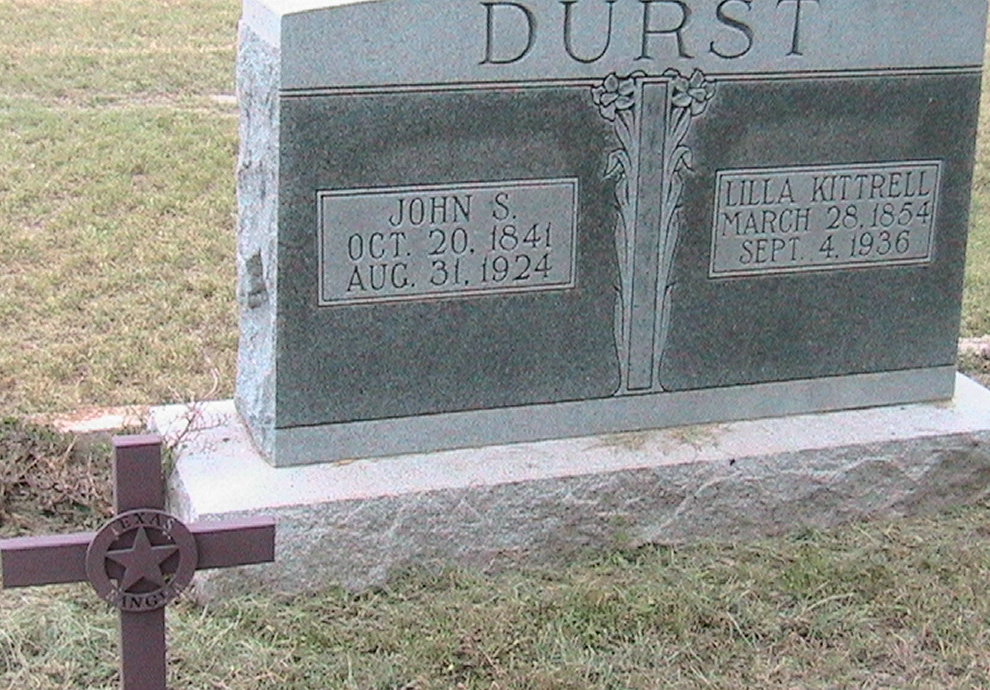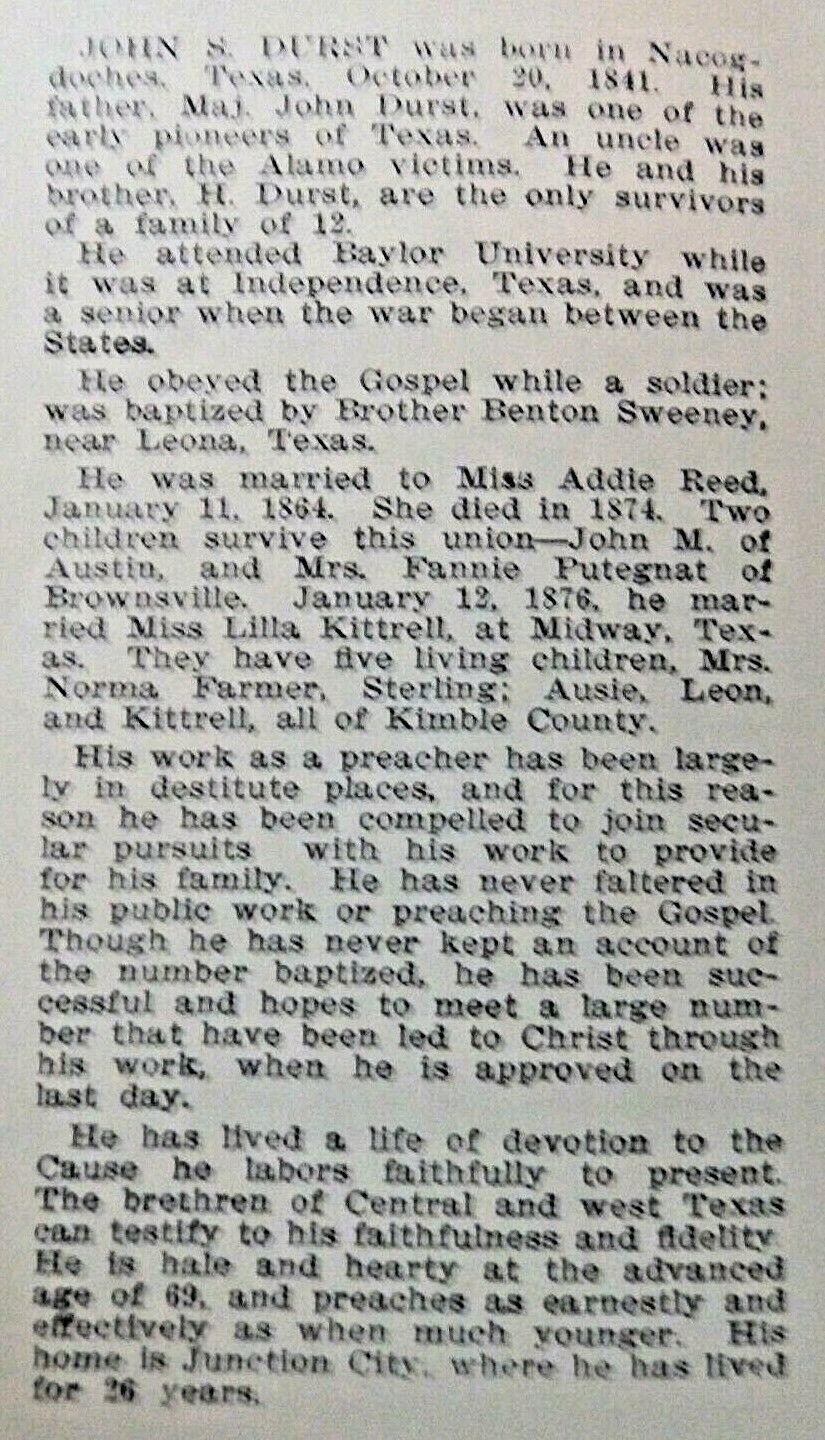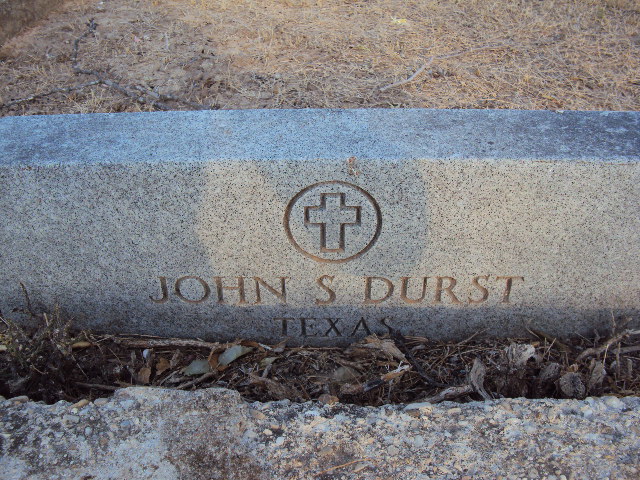Preacher Who Died at Menard Born
in Old Stone Fort at Nacogdoches
Special to The News
BROWNWOOD, Texas, Sept. 27, - The Rev. John S. Durst died a few days ago at Menard, following an illness of lengthy duration.
John Sterling Durst was born in the Old Stone Fort at Nacogdoches Oct. 20, 1841, his father having been a pioneer of that section. At the outbreak of the Texas Revolution, Mr. Durst was a Representative from Texas in the Legislature of Monclova and Texas, the Legislature holding its sessions at Monclova. In later years the family moved to Leon County, and the father of the Rev. John Sterling Durst in 1846 named that county in honor of Capt. Alonzo de Leon. De Leon was one of the original men to whom extensive land grants were made by the Mexican and Spanish Governments.
In 1880 the Rev. John S. Durst moved to Kimble County, where he resided until his death. At that time there were very few settlements in this part of the State, and in the forty-four years that he lived in the great section of which Kimble was the center he took an active part in educational and religious affairs, being in every sense of the word a real missionary and pioneer educator.
The old fort at Nacogdoches, which was torn down some years ago, was built in 1778, according to the most authentic information by Senor Gil y Barbo. The most authentic information also indicates that it was not intended for a fort but for a place of refuge and strong house in case of attack. The fact that there were no loopholes in the walls leads to that conclusion. In its time it was put to various uses, being a residence, courthouse, alcalde office and saloon in turn as the years passed.
History and legend tell of the many important incidents that took place between its walls. Sam Houston spent many a night there, David Crockett spent one or two days and nights there on his way from Tennessee to San Antonio, where he lost his life; General Thomas J. Rusk spent days and nights there. Gen. James Long was there in 1819, when he came from the Neutral Ground with his revolution, and it was there, so legend says, that the first printing press in Texas was set up by Horatio Biglow, in 1812. It was there, too, that the Fredonian rebellion of Hayden Edwards had its inception in 1824.
The Edwards family was noted in song and story. The Nacogdoches branch was decended, so legend says, from Charles Edward Stewart, the young pretender to the British throne, who came to the United States, married the Widow Wade in Virginia and then moved to what was in early days Mississippi Territory. He finally left that part of the country and returned to England. It was his brother, Robert Edward Stewart, or Robert Edwards, who owned the land in New York City which has interested the Edwards family many years, and on which a lease is said to have expired many years ago.
Dallas Morning News
September 28, 1924.
Preacher Who Died at Menard Born
in Old Stone Fort at Nacogdoches
Special to The News
BROWNWOOD, Texas, Sept. 27, - The Rev. John S. Durst died a few days ago at Menard, following an illness of lengthy duration.
John Sterling Durst was born in the Old Stone Fort at Nacogdoches Oct. 20, 1841, his father having been a pioneer of that section. At the outbreak of the Texas Revolution, Mr. Durst was a Representative from Texas in the Legislature of Monclova and Texas, the Legislature holding its sessions at Monclova. In later years the family moved to Leon County, and the father of the Rev. John Sterling Durst in 1846 named that county in honor of Capt. Alonzo de Leon. De Leon was one of the original men to whom extensive land grants were made by the Mexican and Spanish Governments.
In 1880 the Rev. John S. Durst moved to Kimble County, where he resided until his death. At that time there were very few settlements in this part of the State, and in the forty-four years that he lived in the great section of which Kimble was the center he took an active part in educational and religious affairs, being in every sense of the word a real missionary and pioneer educator.
The old fort at Nacogdoches, which was torn down some years ago, was built in 1778, according to the most authentic information by Senor Gil y Barbo. The most authentic information also indicates that it was not intended for a fort but for a place of refuge and strong house in case of attack. The fact that there were no loopholes in the walls leads to that conclusion. In its time it was put to various uses, being a residence, courthouse, alcalde office and saloon in turn as the years passed.
History and legend tell of the many important incidents that took place between its walls. Sam Houston spent many a night there, David Crockett spent one or two days and nights there on his way from Tennessee to San Antonio, where he lost his life; General Thomas J. Rusk spent days and nights there. Gen. James Long was there in 1819, when he came from the Neutral Ground with his revolution, and it was there, so legend says, that the first printing press in Texas was set up by Horatio Biglow, in 1812. It was there, too, that the Fredonian rebellion of Hayden Edwards had its inception in 1824.
The Edwards family was noted in song and story. The Nacogdoches branch was decended, so legend says, from Charles Edward Stewart, the young pretender to the British throne, who came to the United States, married the Widow Wade in Virginia and then moved to what was in early days Mississippi Territory. He finally left that part of the country and returned to England. It was his brother, Robert Edward Stewart, or Robert Edwards, who owned the land in New York City which has interested the Edwards family many years, and on which a lease is said to have expired many years ago.
Dallas Morning News
September 28, 1924.
Gravesite Details
2C4R
Family Members
-
![]()
Louis Orlando Durst
1827–1859
-
![]()
Mary Benigna Durst Blake
1830–1864
-
![]()
Charles Placide "Bruno" Durst
1832–1905
-
Alexander H. Durst
1834–1840
-
Angelina Anna Durst
1837–1841
-
![]()
Harriet Matilda Durst Hopkins
1839–1871
-
![]()
Horatio Walter "Rashe" Durst
1844–1930
-
![]()
Clara Elizabeth Durst
1846–1856
-
![]()
Eugene Marcelino Durst
1849–1849
-
Clara M. Durst
1866–1867
-
![]()
John Montgomery Durst
1868–1916
-
![]()
Fannie Adelaide Durst Putegnat
1873–1965
-
![]()
Norma Louise Durst Farmer
1877–1979
-
William Kittrell "Willie" Durst
1879–1880
-
![]()
Sterling Orlando "Sod" Durst
1882–1966
-
![]()
Austin McGary "Miss Ausie" Durst
1889–1973
-
![]()
LTC Leon Herman Durst
1892–1971
-
![]()
Kittrell Goree Durst
1894–1961

























